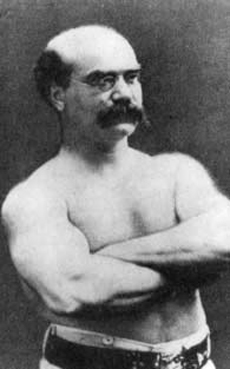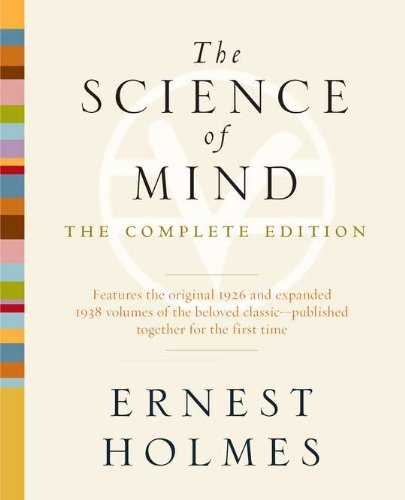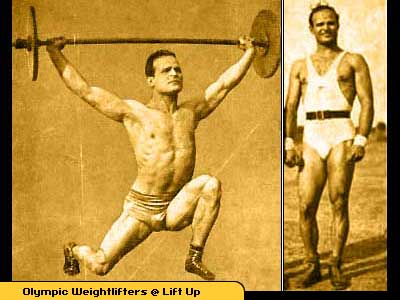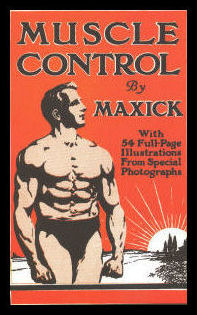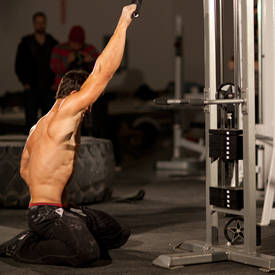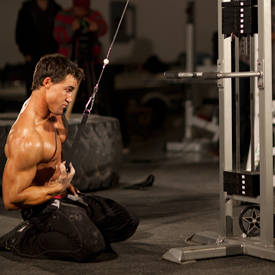There was a time when Olympic lifting was the sole preserve of elite weightlifters in countries such as China, Bulgaria and the old Soviet Union. It was considered to be a highly specialized form of training for a select few elite athletes who training for performance rather than aesthetics. But one look at the physique of current world and Olympic weightlifting champion Lü Xiaojun from China shows Olympic lifting has aesthetic benefits too.
Larger muscle fibers, huge traps, impressive quads and low body fat are just a few of the advantages.
So let's look at the power clean, front squat, snatch, and jerk and see how adding such moves to your routine could prepare you for the beach as well as the lifting platform, and then try the workout devised by Team GB Weight Lifting performance director Tommy Yule that incorporates Olympic lifting into a conventional strength plan.
Olympic Lifting: The Basics
Weightlifting has a rich history. Britain's Edward Lawrence Levy --
-- won the first world championships in 1891 and the sport was contested at the first modern Olympics in 1896. [Note: For detailed documentation and rare photos on lifting at the early modern Olympics see the works of Gherado Bonini -
Olympic Games weightlifting today consists of two disciplines -- the Snatch, and the Clean and Jerk. Each athlete gets three attempts at each lift and then the two lifts are added up to make a total and an overall result. So how is this relevant to ordinary gym-goers?
Human skeletal muscle contains two key types of muscle fibers -- type I and type II. Type I fibers are more commonly known as slow twitch and are used in endurance training. They have a much slower contractile speed and a smaller cross-sectional area, which means they're resistant to fatigue but not so good for building muscle.
Type II fibers are more commonly knows as fast twitch fibers. They have a faster contractile speed and a larger cross-sectional area. They generate power so you want lots of them for lifting heavy in the gym. Also, their larger cross-sectional size helps you look more impressive. So, how do you develop them? The simple answer is by Olympic lifting.
Research at the University of Memphis showed that when competitive lifters were compared, those typically utilizing the heaviest loads (90% of their one-rep max or higher) -- that is, weightlifters and powerlifters -- exhibited a preferential hypertrophy of type II fibers when compared with bodybuilders using lower percentage loads. This data suggests that maximal hypertrophy occurs with loads from 80-95% of one-rep max.
Granted, bodybuilders are the foremost experts in muscle growth (hypertrophy) and the same study did state that bodybuilders experienced hypertrophy "equally in both type I and type II fibers," but this does raise the interesting point that if you want to increase the size and strength of your muscles by targeting the larger type II muscle fibers, Olympic-style lifting would work well as an integral part of your program.
That's not to say you should ditch conventional forms of hypertrophy training and concentrate solely on Snatches and Cleans. But it would make sense to drill the techniques and incorporate the moves once or twice a week.
Anabolic Boost
The next important component of Olympic-style lifting to consider is the anabolic hormone response. Scientists from the Department of Sport and Exercise Science at the University of Auckland set out to analyze this.
In a study into competitive weightlifting they stated that during the Snatch, and Clean and Jerk, elite lifters "have achieved some of the highest absolute and relative peak power outputs in the literature." This, in turn, produces similar spikes in testosterone and growth hormone that are experienced during heavy compound bodybuilding-type training.
Researchers from the Institute of Biomedical Engineering at Imperial College London also reported a direct correlation between spikes in anabolic hormones and one-rep-max lifts in Olympic lifters. Again, that's not to say if you Clean and Jerk 100-kg-plus above your head every week you're going to be walking around permanently anabolic with elevated testosterone levels. If anything, the strain this would put on your body could lead to overwork. But including such lifts in your training once or twice a week would send a natural anabolic surge of hormones through the body.
Getting Lean
Research in the Journal of Applied Physiology as far back as 1994 showed the positive effects strength training could have on body composition. Scientists asked 13 untrained healthy men to complete a 16-week strength training program. Body fat and muscle composition were then measured using dual-energy X-ray absorptiometry (DEXA). Following 16 weeks, all the men completing the strength training protocol subjects' post-exercise metabolic rate -- the rate at which their metabolism remains elevated and they keep burning calories -- remained high for a "prolonged period and may enhance post-exercise lipid oxidation."
Put simply, it means weight training increase the rate at which you burn calories long after you've put down the bar -- something steady-paced cardio doesn't do so effectively.
Thus, research indicates Olympic lifting could dramatically improve body composition. Better still, it means not necessarily losing weight but rather, increasing muscle mass and lowering your body fat at the same time.
Yule's Rules
I am a keen practitioner of Olympic-style lifting, but few men know more about it than Tommy Yule, who has put together the following Olympic lifting routine for aesthetics. Tommy says the routine is devised to compliment rather than replace traditional bodybuilding movements.
It is based on the principle that all movements have a kinetic chain. Dr. Arthur Steindler -- one of the early pioneers of this theory -- defines this a "a combination of several successively arranged joints constituting a complex motor unit." In other words, how all your joints and movements work together during a squat, bench, or deadlift.
Olympic-style lifting highlights any weak links in the kinetic chain. You might be able to grind out a deadlift or squat, but not a Snatch, because all the joints and muscles must be firing at their optimal level to complete the move.
Olympic-style lifting with sub-maximal weights is also believed to prepare the body with neural recruitment/activation before big lifts like deadlifts. The high level of motor recruitment needed for an Olympic lift preps the body to then lift big during a deadlift of squat. What follows, therefore, is designed to generate better results than a traditional hypertrophy program.
THE PROGRAM
Monday - Squat Clean and Legs
Squat Clean - 4 sets of 8 reps with submaximal weight (65% of your 1 rep max.)
Emphasis on speed, kinetic flow and motor recruitment that prepares the body for subsequent lifts.
Front Squat - 5 sets of 5 (80% of 1-rep max)
Emphasis on strength and quality of movement, maintaining the same form of efficiency you achieved during the squat clean.
Lunge - 4 sets of 20 (60% or 1-rep max)
Emphasis on form, hypertrophy and volume.
Calf Raise - 5 sets of 10 (70% of 1-rep max)
Emphasis on form and hypertrophy.
Tuesday - Arms and Abs
Seated/Standing Barbell Curl - 5 sets of 10 (70% of 1-rep max)
Emphasis on form and hypertrophy. Following a large compound day it's wise to periodize your training with smaller, lower volume isolation days. Abs and arms are perfect for this.
Hammer Curl - 5 sets of 10 (70% of 1-rep max)
Emphasis on form and hypertrophy.
Weighted Triceps Dip - 5 sets of 5 ( 80% of 1-rep max)
Emphasis on strength and quality of movement.
Pallof (Press) Hold - 3 sets of 1-minute holds each side.
Emphasis on form and core engagement.
Weighted Leg Raise - 5 sets of 10 reps (70$ of 1-rep max)
Emphasis on form and core engagement.
Wednesday - Rest
It is important to rest prior to the large, heavy, complex movements that are to follow.
Thursday - Clean and Press and Shoulders
Clean and Press - 4 sets of 8 with submaximal weight (65% of 1-rep max)
Emphasis on speed, kinetic flow and motor recruitment that prepares the body for subsequent lifts.
Seated Shoulder Press - 5 sets of 5 (70% of 1-rep max)
Emphasis on strength and quality of movement, maintaining the same form of efficiency you achieved during the clean and press.
Side Lateral Raise - 5 sets of 10 (70% of 1-rep max)
Emphasis on form and hypertrophy.
Front Delt Raise - 5 sets of 10 (70% of 1-rep max)
Emphasis on form and hypertrophy.
Friday - Snatch and Back
Snatch - 4 sets of 8 reps with submaximal weight (65% of 1-rep max)
Emphasis on speed, kinetic flow and motor recruitment that prepares the body for subsequent lifts.
Deadlift - 5 sets of 3 reps (85-90% of 1-rep max)
Emphasis on strength and quality of movement, maintaining the same form of efficiency you achieved during the Snatch.
Weighted Pullup - 5 sets of 5 (80% of 1-rep max)
Emphasis on strength and quality of movement, maintaining the same form of efficiency you achieved during the Snatch and Deadlift.
Bentover Row - 5 sets of 10 reps (70% of 1-rep max)
Emphasis on form and hypertrophy.
Saturday - Chest and Triceps
Bench Press - 5 sets of 5 reps (80% of 1-rep max)
Emphasis on strength and quality of movement, maintaining the same form of efficiency you developed in the week.
Dumbbell Flye - 5 sets of 10 reps (70% of 1-rep max)
Emphasis on form and hypertrophy.
Close-Grip Bench Press 5 sets of 10 reps (70% of 1-rep max)
Emphasis on form and hypertrophy.
Triceps Pushdown - 10 sets of 10 reps (65% of 1-rep max)
Emphasis on form, hypertrophy and volume.
Sunday - Rest
It is important to rest prior to the large, heavy, complex movements that are to follow.



